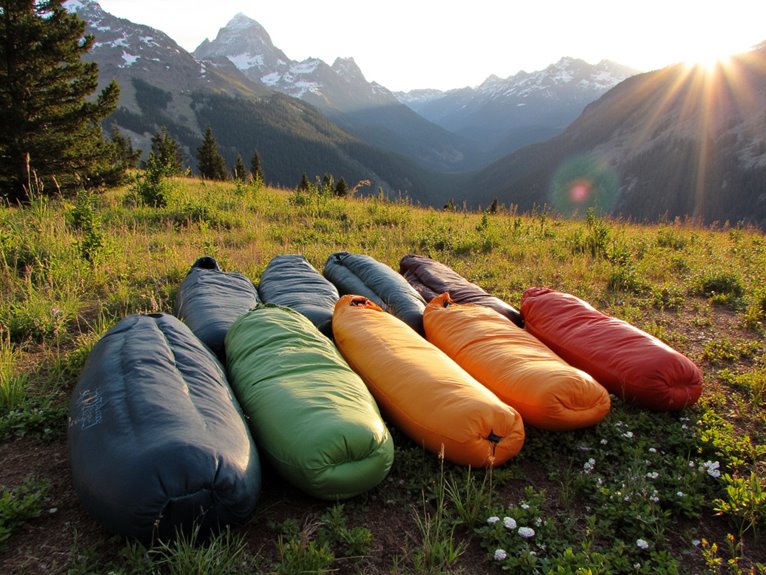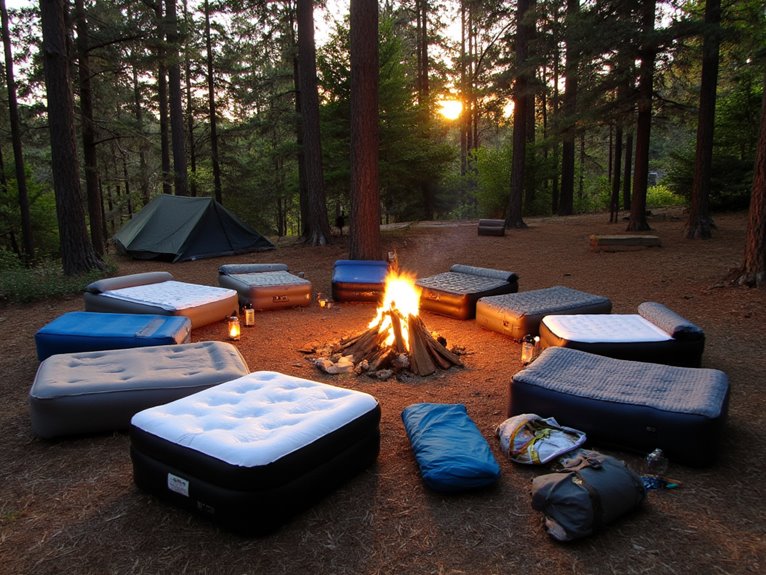Types of Sleeping Bag Insulation
You’ll encounter three main sleeping bag insulation types: down, synthetic, and hybrid. Down offers the best warmth-to-weight ratio with 800+ fill power ratings but requires dry conditions. Synthetic insulation retains warmth when wet and dries faster, making it ideal for humid environments. Hybrid options combine both materials for balanced performance. Specialized variants include bonded synthetic for consistent thickness and loose-fill synthetic as down alternatives. Understanding these distinctions will help you explore specific performance characteristics for your camping needs.
We are supported by our audience. When you purchase through links on our site, we may earn an affiliate commission, at no extra cost for you. Learn more. Last update on 4th December 2025 / Images from Amazon Product Advertising API.
Notable Insights
- Down insulation offers the best warmth-to-weight ratio with 800+ fill power but requires dry conditions to maintain performance.
- Synthetic insulation retains warmth when wet, dries faster than down, and costs 30-50% less than comparable down bags.
- Hybrid insulation combines down’s lightweight properties with synthetic’s moisture resistance through strategic material placement in key areas.
- Fill power ratings from 400-900 indicate down quality, with 600-700 suitable for most conditions and 800+ optimal for ultralight backpacking.
- Down insulation lasts 15-20 years with proper care while synthetic materials typically have a 5-10 year lifespan.
Down Insulation: The Gold Standard for Warmth-to-Weight Ratio
When you’re selecting a sleeping bag for backcountry adventures, down insulation stands as the premium choice for serious outdoor enthusiasts who prioritize weight savings without sacrificing warmth.
Down insulation benefits include exceptional thermal efficiency and superior compressibility compared to synthetic alternatives. Premium down achieves 800+ fill power ratings, measuring the space occupied when expanded. Higher fill power translates to greater loft and better warmth retention per ounce.
Down compresses remarkably smaller than synthetic insulation while maintaining consistent performance over decades. However, down insulation care requires attention to moisture management since wet down loses insulating properties rapidly.
You’ll find down excels in dry, cold conditions where packability matters most. Down insulation is lightweight and compressible, making it ideal for cold, dry conditions where every ounce in your pack counts. Proper storage uncompressed and maintaining cleanliness extends lifespan substantially for ultralight backpacking applications. Down’s unique properties allow it to form air pockets, trapping and retaining body heat effectively throughout the night.
For ultralight backpacking, sleeping bags with 600+ fill power down and weighing under 2 pounds provide optimal warmth-to-weight ratios for extended hiking trips.
Synthetic Insulation: Reliable Performance in Wet Conditions
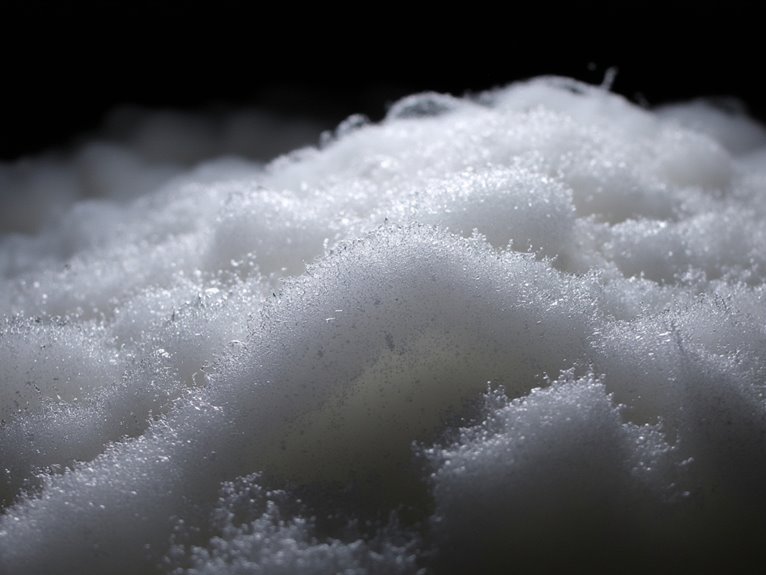
While down excels in dry conditions, synthetic insulation delivers consistent performance where moisture presents a constant threat.
You’ll find synthetic fibers retain considerably less water than down, maintaining warmth even when soaked. These polyester-based materials dry faster and provide reliable heat retention in humid environments.
Synthetic durability proves superior for frequent use and compression cycles. The fibrous structure won’t clump when wet, unlike down that loses all insulating properties.
Advanced construction methods like shingles and specialized layering maximize loft and air trapping capabilities. Branded products like Thermolite® maintain their loft longer than generic synthetic varieties.
The moisture resilience makes synthetic insulation ideal for coastal camping and unpredictable weather conditions.
You’ll sacrifice some packability and warmth-to-weight ratio compared to down, but gain dependable performance and easier maintenance requirements. Synthetic insulation also provides hypoallergenic options for those with sensitivities to down materials.
Hybrid Insulation: Best of Both Worlds
You can achieve ideal insulation performance by choosing hybrid sleeping bags that strategically combine down and synthetic fill materials.
These bags deliver the superior warmth-to-weight ratio of down while maintaining the moisture resistance of synthetic insulation, creating a balanced solution for variable weather conditions.
Modern hybrid construction techniques allow manufacturers to place each insulation type where it performs best—synthetic fill in high-moisture areas like the foot box and down fill in areas requiring maximum loft and warmth retention. The synthetic components ensure the bag retains warmth even when exposed to wet conditions, while the down sections provide exceptional compressibility for easy packing.
Some manufacturers take hybrid design further by creating elephants foot style bags that feature insulation only from the waist down, designed to pair with down parkas for a complete sleep system. Advanced hybrid bags may feature materials like hydrophobic down that combines the benefits of traditional down with enhanced moisture resistance for superior performance in challenging conditions.
Balanced Performance Benefits
Hybrid insulation represents the evolution of sleeping bag technology, combining natural down’s exceptional warmth-to-weight ratio with synthetic fibers’ moisture resistance.
This configuration delivers superior heat retention while maintaining effective moisture management in challenging conditions. You’ll experience consistent warmth even when your bag encounters dampness. The synthetic components prevent down collapse, preserving loft at 80-90% capacity in wet conditions compared to pure down’s 20-30% retention.
Weight remains competitive at just 10-15% heavier than equivalent down bags. Packability stays excellent due to down’s compressible nature.
Your hybrid bag compresses to 65-75% of synthetic alternatives while offering enhanced durability. The synthetic fibers protect down clusters from moisture damage, extending lifespan by 40-50%. This balanced approach eliminates choosing between warmth and weather resistance, delivering reliable performance across diverse outdoor conditions. These hybrid designs maximize packing efficiency while maintaining the superior thermal properties needed for challenging expeditions. Proper technique remains crucial since even premium hybrid gear can be rendered ineffective by common mistakes in preparation and use.
Construction Variety Options
Manufacturing techniques for hybrid sleeping bags vary considerably in how they distribute and combine down and synthetic insulation materials.
You’ll find several distinct insulation layering techniques across different brands and models. Some manufacturers use strategic zoning, placing synthetic fill in moisture-prone areas like the foot box and lower sections while positioning down in the torso region for maximum warmth-to-weight efficiency.
Other designs fully blend both materials throughout the entire bag construction.
Moisture resistance options depend heavily on placement strategy. Patagonia’s approach uses down only in the upper half, creating targeted weight savings.
Complete layering systems sandwich synthetic materials between down chambers, providing backup insulation if moisture compromises the down’s loft. These construction methods offer varying performance profiles for different environmental conditions. Premium manufacturers like Western Mountaineering often utilize 850+ fill power goose down in their hybrid constructions for superior loft and compressibility. The effectiveness of these insulation materials depends on their ability to trap air within fibers, which creates the essential barrier between your body heat and the cold external environment.
Loose-Fill Synthetic: Advanced Alternative to Traditional Down
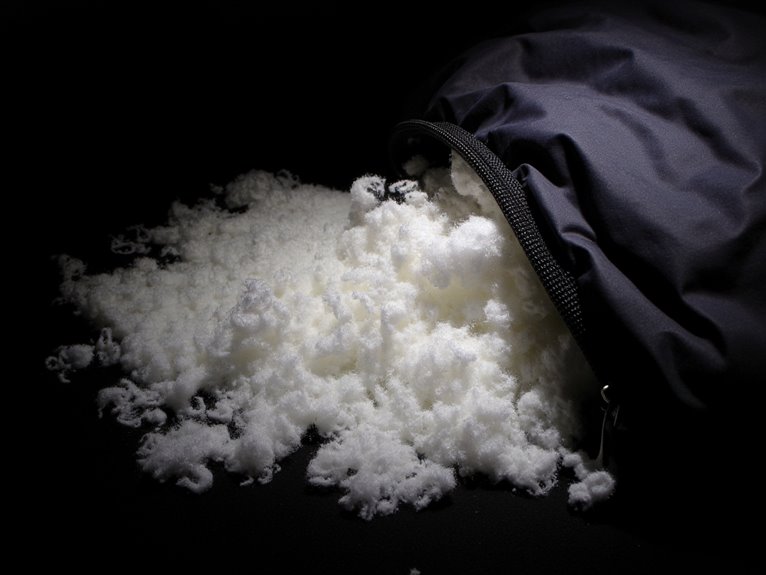
Loose-fill synthetic insulation represents a significant advancement in sleeping bag technology, offering many of down’s desirable characteristics without its moisture-related vulnerabilities.
Quality Variability between brands necessitates careful selection. Modern hollow-core fibers maximize Thermal Efficiency by trapping air while reducing bulk.
Key advantages include:
- Moisture resistance – Maintains loft when wet, unlike traditional down
- PrimaLoft technology – Silicone-treated fibers enhance water resistance
- Hybrid compatibility – Combines effectively with down for peak performance
- Ethical sourcing – Avoids animal welfare concerns
You’ll find synthetic insulation requires more material than down for equivalent warmth. However, specialized patterning techniques and manufacturing processes continually improve compressibility.
Recent innovations produce warmer, lighter options that narrow the performance gap while maintaining superior wet-weather reliability. When selecting a sleeping bag, consider that temperature ratings are essential for choosing the appropriate bag for your specific outdoor conditions.
Bonded Synthetic Insulation: Budget-Friendly Consistency

Bonded synthetic insulation takes a different approach from loose-fill alternatives by fusing synthetic fibers into continuous sheets using heat and resin processes. This construction eliminates the need for internal baffles since the bonded sheets won’t shift or migrate during use.
You’ll find consistent thickness throughout the sleeping bag, preventing cold spots that plague loose-fill designs. The cost effective durability makes bonded synthetic insulation popular for budget-conscious users.
These sheets maintain their loft better than generic synthetic fills while offering superior moisture resistance compared to down. When your sleeping bag gets wet, the insulation continues performing effectively.
Bonded synthetic insulation outperforms loose fills in loft retention and surpasses down in wet conditions, delivering consistent warmth when moisture strikes.
The bonded construction simplifies manufacturing, reducing production costs while delivering reliable warmth retention. You’ll appreciate the straightforward care requirements and quick-drying properties during extended outdoor adventures.
Many budget sleeping bags priced under $200 feature bonded synthetic fills with 210T polyester shells that provide excellent water resistance while maintaining affordability.
Fill Power Ratings: Understanding Down Quality Measurements
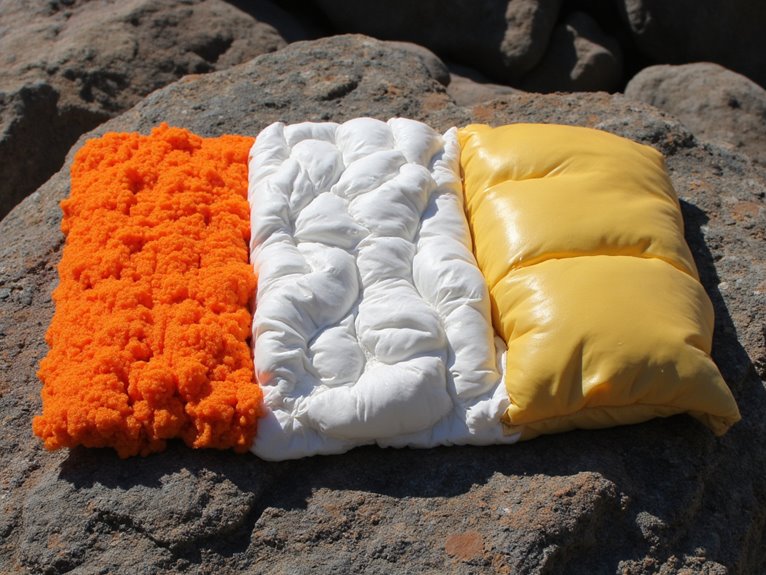
Fill power represents the cornerstone measurement for evaluating down insulation quality in sleeping bags.
You’ll encounter ratings from 400 to 900, where each number indicates how many cubic inches one ounce of down can fill. Higher ratings mean superior down quality and performance.
Testing involves compressing down under a weighted disk in a cylinder, then measuring volume after one minute. This standardized method guarantees consistent quality assessments across manufacturers.
Key Fill Power Benefits:
- Weight Reduction – 800+ fill power requires less material for equivalent warmth
- Enhanced Compressibility – Higher ratings pack smaller for backpacking
- Superior Loft – Better air pocket creation improves insulation efficiency
- Durability – Premium down quality maintains performance longer
You’ll find 600-700 fill power suitable for most conditions, while 800+ excels in ultralight applications where every ounce matters.
Shell Fabrics and Their Impact on Performance
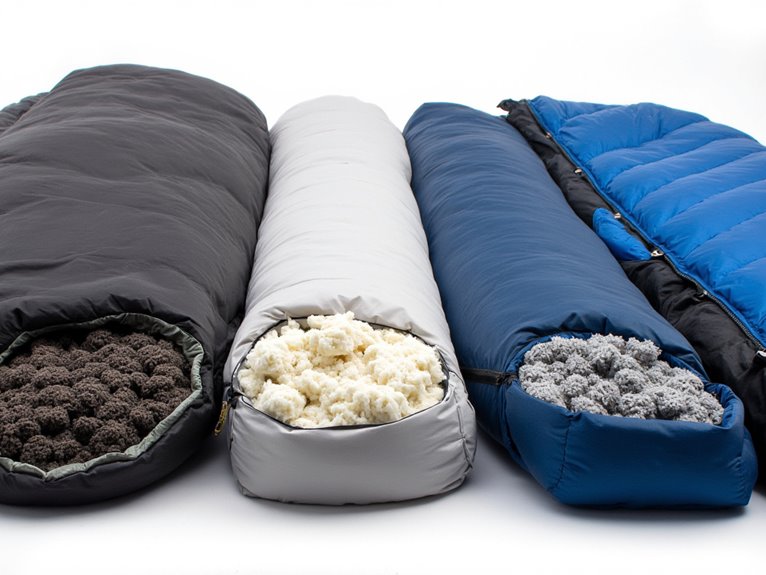
While insulation generates warmth, your sleeping bag’s shell fabric determines how effectively that heat stays trapped inside. Most manufacturers use polyester or nylon shells ranging from 10–20 denier for ultralight applications to 30–80 denier for heavy-duty use.
Ripstop weaves enhance fabric durability without significant weight penalties.
Durable Water Repellent (DWR) finishes provide essential moisture management by preventing surface water from saturating your insulation. This coating isn’t fully waterproof but maintains breathability while protecting down and synthetic fills from dampness.
DWR degrades over time and requires periodic reapplication.
Breathability varies by weave and treatment, not just denier count. Proper air permeability reduces internal condensation while maintaining warmth retention.
Ultralight fabrics excel for fastpacking, while heavier shells withstand extended expeditions and rough terrain. When packing your sleeping bag for travel, compression sacks with ripstop nylon construction can reduce bulk by up to 40% while providing additional protection for your investment.
Construction Methods: How Insulation Is Layered and Arranged
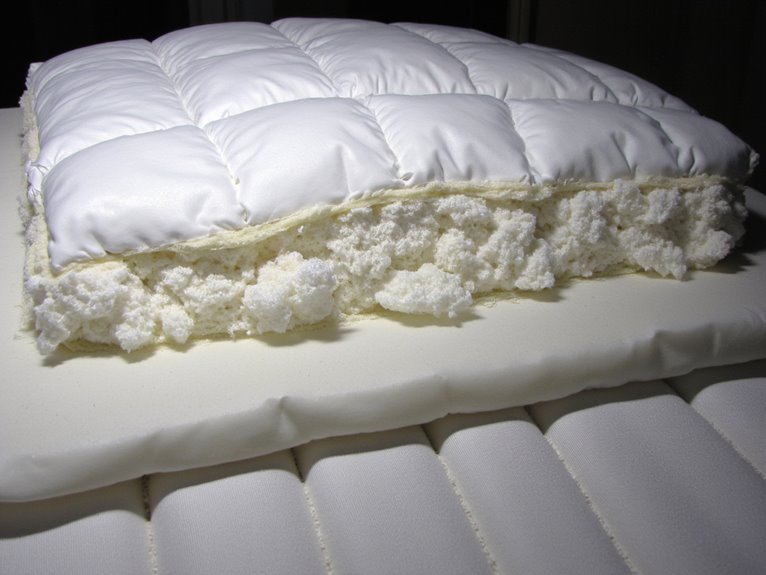
Beyond fabric choice lies the engineering challenge of arranging insulation to maximize warmth while minimizing cold spots. Your sleeping bag’s construction method directly impacts thermal efficiency and durability.
The real engineering test isn’t just choosing materials—it’s strategically positioning insulation to eliminate thermal gaps and maximize heat retention.
Manufacturers employ several proven techniques:
- Layered Construction – Multiple insulation layers work together, with offset positioning preventing thermal bridging.
- Quilted Layers – Direct stitching through insulation maintains structural integrity but creates potential cold spots.
- Baffle Systems – Compartments prevent down migration while allowing proper loft distribution.
- Differential Cut – Liner sizing allows insulation to expand around compressed areas beneath your body.
Synthetic bags typically use layered construction with shingled arrangements.
Down bags rely on baffled compartments or sewn-through designs.
Quilted layers offer simplicity but reduce thermal performance compared to offset systems that eliminate stitching penetration points.
Choosing the Right Insulation for Your Needs

Your choice of sleeping bag insulation depends primarily on the climate conditions you’ll face and your specific outdoor activities.
Budget constraints often determine whether you can afford premium down insulation or need to evaluate synthetic alternatives that offer solid performance at lower costs.
The key is balancing your performance requirements—like warmth-to-weight ratio and moisture resistance—with what you’re willing to spend and the environmental conditions you expect to encounter.
Climate and Activity Considerations
Selecting the appropriate sleeping bag insulation depends heavily on the specific climate conditions and activities you’ll encounter during your outdoor adventures. Temperature extremes and activity levels directly influence your insulation choice.
Down excels in cold, dry environments where weight matters most. It provides superior warmth-to-weight ratios for backpacking trips.
Synthetic insulation performs better in wet conditions, maintaining thermal properties when moisture is present. It also handles high-sweat activities effectively due to faster drying times.
Key Climate and Activity Factors:
- Moisture exposure – Choose synthetic for humid or wet environments
- Pack weight constraints – Select down for ultralight backpacking requirements
- Temperature consistency – Use down for stable cold conditions
- Activity intensity – Pick synthetic for high-output adventures
Hybrid options balance both performance characteristics for variable conditions.
Budget and Performance Balance
Three critical factors determine whether you’ll get peak value from your sleeping bag investment: upfront cost, long-term durability, and performance in your specific outdoor conditions.
Synthetic insulation delivers excellent budget performance for casual campers, typically costing 30-50% less than comparable down bags. Down insulation offers superior insulation longevity—lasting 15-20 years with proper care versus 5-10 years for synthetic materials.
If you’ll encounter wet conditions frequently, synthetic’s moisture resistance justifies its shorter lifespan. For predictable dry environments, down’s exceptional warmth-to-weight ratio makes it worth the premium.
Hybrid insulation splits the difference, combining down’s efficiency with synthetic’s weather resistance.
Calculate your annual camping days and expected conditions to determine which insulation type maximizes long-term value for your specific outdoor pursuits.
Frequently Asked Questions
How Long Does Down Insulation Typically Last Before Losing Effectiveness?
Down insulation longevity in your sleeping bag typically ranges from 10-15 years under regular use.
You’ll maintain effectiveness over time through proper care and storage. Quality down bags can last 30+ years with minimal use and excellent maintenance.
Your bag’s down insulation longevity depends on fill power, usage frequency, and storage methods.
You’ll notice decreased loft and clumping when effectiveness diminishes, signaling replacement time.
Can Synthetic Insulation Cause Allergic Reactions Like Down Does?
You’ll rarely experience synthetic allergies compared to down insulation reactions.
Synthetic materials lack animal proteins that trigger most sleeping bag allergies. However, insulation reactions can still occur from chemical additives or manufacturing treatments.
You’re more likely to react to dust mites accumulating in any sleeping bag type.
Regular washing eliminates most allergens in synthetic bags, making them the safer choice for allergy-prone individuals.
What’s the Price Difference Between Down and Synthetic Sleeping Bags?
You’ll find down sleeping bags typically start around $300, while synthetic options cost considerably less.
The price comparison shows you’re paying approximately $200 more for down’s superior warmth-to-weight ratio and compressibility.
However, material durability favors down bags as long-term investments. Duck down provides a middle-ground option with fill power up to 650.
Synthetic bags offer better value for budget-conscious buyers prioritizing affordability over premium performance.
How Do I Store My Sleeping Bag to Maintain Insulation Quality?
You’ll preserve your sleeping bag’s insulation by following proper storage tips.
Remove it from the compression sack and store it loose in a large, breathable cotton or mesh sack. Choose a cool, dry location with good ventilation.
Make sure the bag’s completely dry before storage to prevent mold.
These insulation preservation methods prevent fiber damage and maintain loft for maximum thermal performance.
Can Damaged Insulation in Sleeping Bags Be Repaired or Replaced?
You can perform basic insulation repairs on damaged bags through several methods. Simple synthetic fiber redistribution restores some thermal value.
Patch small shell tears to prevent further insulation loss. However, severely clumped down or extensive synthetic breakdown requires full replacement, typically costing 60-80% of a new bag’s price.
Professional services guarantee proper loft restoration, though DIY spot repairs work for minor damage.
On a final note
You’ll find each insulation type serves specific purposes in your outdoor pursuits. Down delivers unmatched warmth-to-weight efficiency for dry conditions. Synthetic options won’t fail when wet but add extra weight. Hybrid designs combine both benefits at higher costs. Consider your typical camping environment, temperature ranges, and budget constraints. Match fill power ratings to your coldest expected conditions. Quality shell fabrics and construction methods determine long-term durability and performance consistency.



